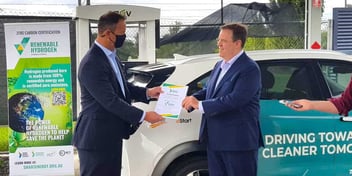Splitting water: The researchers improving hydrogen production
With the world’s appetite for renewable energy increasing rapidly, hydrogen offers an excellent alternative to oil-based fuel sources. However, producing hydrogen sustainably and cost effectively requires an array of expertise and insight. With trading heavyweight Japan seeking to increase hydrogen import, QUT researchers Professors Graeme Millar and Anthony O’Mullane have stepped up to the challenge.
“Hydrogen production has been very topical before and it’s become very topical again, because of drivers like Japan. While a lot of Japanese companies are focused on the idea, they see Australia as an ideal business partner because we have a lot of sun and a lot of coastline,” Millar said.
“Australia may not be the main users of hydrogen, but we may certainly be the main exporters, because we have almost unlimited power from the sun and water from the sea. The great thing is Japan has put a cost on hydrogen, which means we have a bottom line to work with.”
Although Australia offers an ideal location for hydrogen generation, there’s still groundwork involved in establishing cost-efficient processes to meet the required demand.
Professor O’Mullane says electrochemically the science is there, it’s now about improving the process to increase efficiency and durability.
“Once you have purified water, you add what we call an electrolyte, which makes the water conductive. Typically we use an alkaline solution, potassium hydroxide. Then, we can use electrochemistry to split it into hydrogen and oxygen,” O’Mullane said.
“One of the issues we have with water splitting is the need to develop durable electrodes that are also active enough to drive the reaction efficiently. You need excellent catalysts for not only generating hydrogen, but also oxygen. If one electrode does not work as well as the other, your overall process is compromised.
"At QUT, we are working on developing both sides so that we have electrodes that can do this as efficiently as possible, so we can produce as much hydrogen as possible, while also lowering the amount of energy needed to facilitate the process by using renewable energy sources like wind and solar.”
Building the right processes
And while O’Mullane is busy splitting water, Millar is charged with the task of scaling up the operation, including ensuring water sources are purified and delivered as sustainably as possible.
“The issue, research wise, is how to make hydrogen renewable. We can’t use freshwater because we don’t have enough of it. The first thing we needed is purified water. The most obvious and abundant source is seawater,” Millar said.
“My work is to purify and desalinate that water as cheaply as we can and using renewable energy. From the water treatment side, it’s not only about meeting the market by scaling up but also working with the best processes.”
But it’s not only water treatment that needs attention. Professor Millar said the operation has personnel working on an array of different aspects to ensure the outcome is successful and cost-effective.
“We have a big group of people doing the business side of things, as well as the engineering and hydrogen transport side. It’s a very big challenge to try to produce hydrogen at this scale,” Millar said.
“In terms of the financials, we have a client that expects to have a product delivered at a certain cost. It’s a very commercial transaction but we also want to do the best by the environment. To make it a viable and alternative fuel source, or at least a bigger part of an integrated mix, it really is about making economic sense.”
Collaboration is key
So far, so good, but O’Mullane says working together with an interdisciplinary attitude to make the export dream a reality has been the most crucial element of the project.
“Integrating different technologies at scale is not as straightforward as it sounds. It’s not a question of sticking technology together and having it just work. A lot of research goes into how to invest, the optimum use of materials and making sure all the different requirements are on the same page technologically,” O’Mullane said.
“The project wouldn’t have gotten off the ground if it wasn’t for collaboration. There are chemists, engineers, physicists, planners and business experts all working together.”
Millar said diversifying the expertise involved in the operation was imperative to tackling the challenge offered up by a gap in the international market.
“Industry know what they need better than we do, we are guided by them,” he said.
“We had to diversify. We knew we weren’t going to achieve our goals if we continued with the same way of doing things and that takes collaboration.”

First published in Current magazine October 2018.


